Robots, once limited to the realm of science fiction, are now making their mark in the catering world. These intelligent machines are transforming the way caterers prepare, cook, and serve food, offering unprecedented levels of efficiency, precision, and consistency.
“I think it’s the logical next step. Robotics have been used for decades within the manufacturing sector, and the synergy between human workers and robotic automation has been of enormous benefit to productivity and efficiency,” says Steve Kane, who works with Pringle Robotics in their Hospitality Innovation department. “Now, with advances in smaller, more personable service robots, the hospitality industry can reap similar rewards—especially during this time of labor shortages coupled with increased consumer demand.”
So, how can caterers successfully harness the power of this emerging technology? Let’s take a look at the different robots currently on the market and the different ways they can support catering operations.
Breaking down the bots
Robots, with their articulated arms, multiple cameras, and machine learning, can lend the ultimate helping hand to the hospitality industry by assisting with many of the repetitive or mind-numbing tasks workers must repeat again and again.
“And guess what,” said Michael Stavros during his Catersource + The Special Event 2023 session, Caterers, Assemble! - Tantalizing Trends, Captivating Concepts, Inspired Interactivity, “it doesn’t complain.”
Today’s robots range from front-of-house to back-ofhouse, each with their own specialized functions. Prices can range from a couple hundred to thousands of dollars depending on the model you invest in, and whether you rent or purchase them.
“To grow your business with the ever-changing landscape of technology, I think it’s important to embrace the change and at least try it,” says Robin Selden, Executive Chef with Marcia Selden Catering & Events. “Change is often scary as we are creatures of habit, but if you don’t try it, you’ll never know the benefits it will have.”
Super servers
Probably the most prevalent at this current juncture are service robots, which are popping up in all sorts of scenarios such as in hotels (room service delivery) and during events. For example, they are a good solution for butler-passed service during events.
“Bartenders love our bots because when they finish making a drink, they can simply place the drink on the serving bot and send it to the table where it is needed, rather than waiting for the server to return to the drink station to get it and take it to the customer,” says Kane.
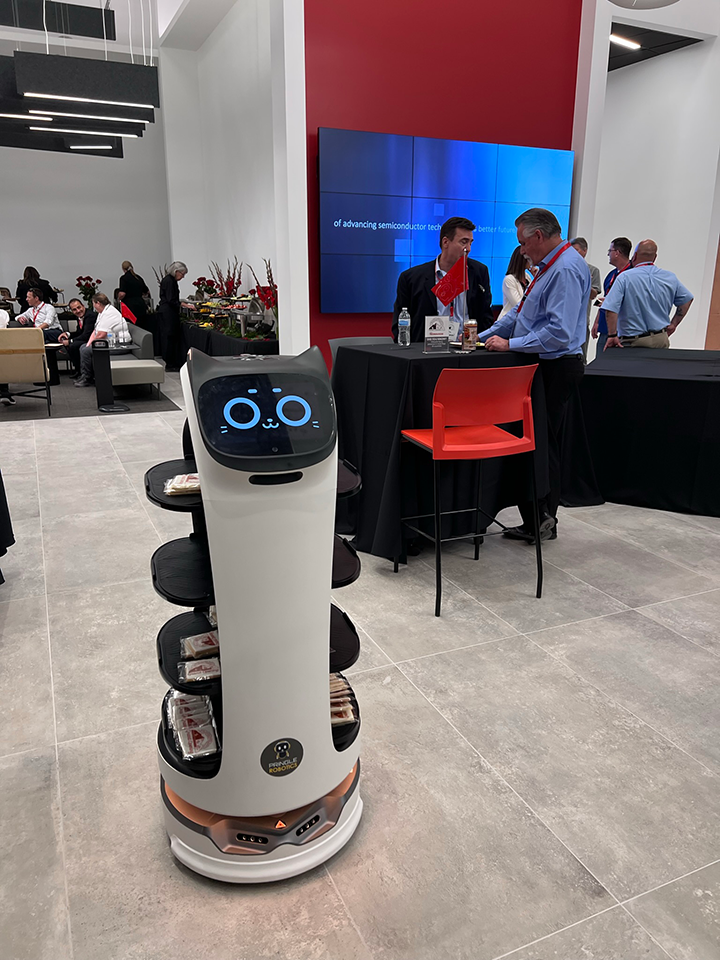
Pringle Robotics currently offers a number of different service robots including KettyBoT, which can be mapped to an event space and programmed to deliver items such as appetizers, beer, water, and swag; BellaBoT (shown), which can accompany serving staff to tables, carrying multiple plates of food at a time and reducing worker fatigue; and HolaBoT, their dish bussing robot that can carry 120 pounds worth of dishes. Photo courtesy Pringle Robotics
These types of robots are outfitted with shelving and can be programmed to move along a pre-designated path bringing beverages and hors d’oeuvres to guests.
“Think of it like a Roomba with shelves,” said Stavros.
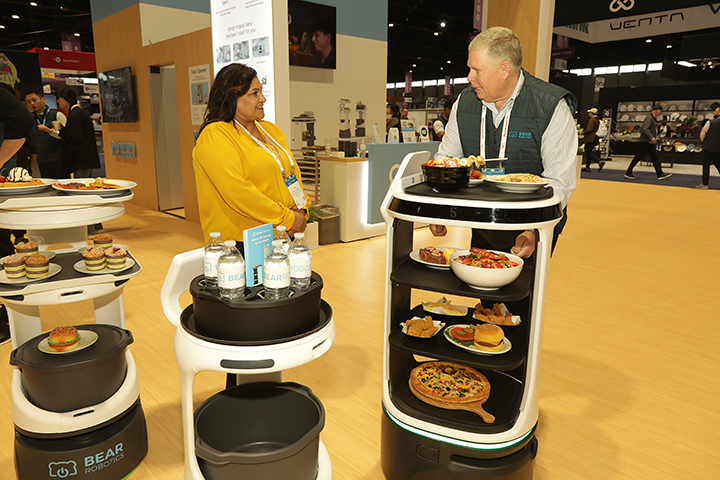
Bear Robotics displayed its Servi robots during the 2023 National Restaurant Association Show. Servi can help run food or bus dishes. Photo courtesy National Restaurant Association
Selden had her first interaction with a service robot in Orlando, FL during Catersource + The Special Event 2023. After requesting some additional towels and bottled water at her hotel, “within minutes there was a buzz at the door. I opened the door and to my surprise there was a robot there, which as you can imagine, blew my mind.
“I was so impressed with this that we ended up calling again the following day as we wanted to video the whole interaction,” she adds. “Sadly, this time when we opened the door, we were met with a smile (which don’t get me wrong, was great) but we were bummed.”
A few of the models on the market include Matradee, Servi, and Pringle’s many service robots. These same robots can also be programmed for table bussing as well. There are even models that help scrub floors.
Some of the service robots on the market are outfitted with video screens, which are great opportunities to include directional information, logos, and even descriptions of signature cocktails or bites. Robots can also assist with guest check-in.
“I definitely think that it would elevate the guest experience and create a great memory,” says Selden. “After all that is our job as memory makers, right?”
But there’s even more potential with robots than just delivery and bussing.
“I can see larger delivery robots being used to transport big quantities of food from kitchen to truck, or truck to venue,” says Kane, “and I do see a place for robots to eventually be right in the kitchen, helping prepare the food.”
Robotic chefs
The emergence of robot chefs is a game-changer in the culinary industry, with their ability to redefine the traditional approach to food preparation and service. Early iterations of the robotic chef included such options as burger flipping bots (Aniai), French fry bots (Miso), sandwich and salad bots (Dexai), and even pizza bots (Picnic Works). But today’s robots can do so much more. With the aid of onboard sensors, optical cameras, and enhanced artificial intelligence technology, these robotic cooks are fundamentally designed to multi-task, executing the actions and movements of professional human cooks in real time.
Most innovative, however, are the fully-automated robotic kitchens being developed by such companies as Moley, REMY, and Nala that include everything from multi-cuisine-making robots to sushi making bots to dishwashing robots to ice cream scooping bots. Robots who can plate are also emerging. This means the robot kitchen can retrieve ingredients from the fridge, adjust oven temperatures, use the sink to fill pans and pour, mix, and plate up just as a human cook would. The robot even cleans up after itself.
These robotic kitchens utilize AI technology to follow pre-recorded chef instructions and are equipped with multiple sensors and machine learning capabilities, enabling it to precisely measure ingredients and execute complex cooking techniques.
“Right now, the general sense is that there’s going to be a lot more robots,” said Dina Zemke, assistant professor at Ball State University, in an article for CNBC. “The recipes are highly standardized. And really, it’s mostly heating and assembly. No one’s creating just the right secret sauce in the back of the house, all of that is provided through a commissary system.”
Beyond robotic chefs, there’s also a growing demand for “smart appliances.” For instance, smart ovens can automatically adjust cooking times and temperatures based on the type of food being prepared, while AI-powered refrigerators can monitor expiration dates and suggest recipes based on the ingredients available.
According to Global Market Estimates the global cooking robot market is projected to grow at a CAGR value of 16.5% from 2022 to 2027, with the multi-cuisine-making segment expected to grow the fastest.
In fact, several companies have already started to implement robotic chefs into their operations. For example, Chartwells Higher Education has added Picnic Works’ Pizza Picnic Station (an automated pizza assembly technology) to several of its college campuses; and dnata—one of the world’s largest air and travel services providers—has implemented Moley’s AI-powered cooking robot into its catering operations, serving up identical dishes at scale.
“I love the idea of a station where somebody walks up to the robotic arm and is telling it what to build for their station item,” Stavros said. “I love the idea of a robotic arm doing a perfectly uniform plate decoration on every single plate that goes out. This is not eliminating the need for chefs, this is not eliminating the need for human touch, but this is offering you that perfect precision piece.”
Beverage bots
Rounding out the robots are the beverage and barista bots that are ready and waiting to serve up libations to waiting customers.
Cocktail making robots have been around for quite some time on cruise ships and during events. Guests select their cocktails from a pre-selected electronic menu, and then the robotic arm dispenses spirits and mixers from bottles hanging from the ceiling or along the bar top. Today’s cocktail bots are growing in both intelligence and sophistication through such options as Cecilia.ai or Rotender, which is essentially a cocktail vending machine that has the capability to interact with guests.
Then there’s BRILLO. Developed by researchers at the University of Naples Federico II, BRILLO can not only whip up a cocktail but can also remember your favorite drink and have a conversation. The robot can gauge whether the tone of a conversation is serious or playful and even ask appropriate questions, or crack a joke, depending on the situation.
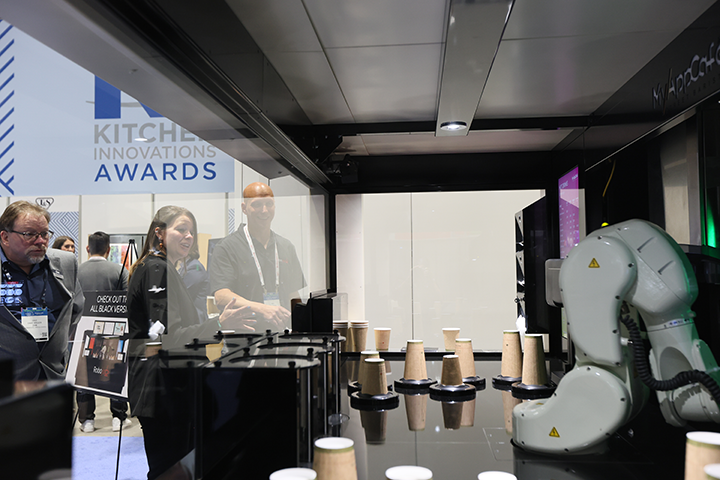
A barista robot served up coffee to attendees during the 2023 National Restaurant Association Show as part of the Kitchen Innovations Awards. Photo courtesy National Restaurant Association
Barista bots (such as Artly), who churn out coffee drinks with mechanical flair, are also trending.
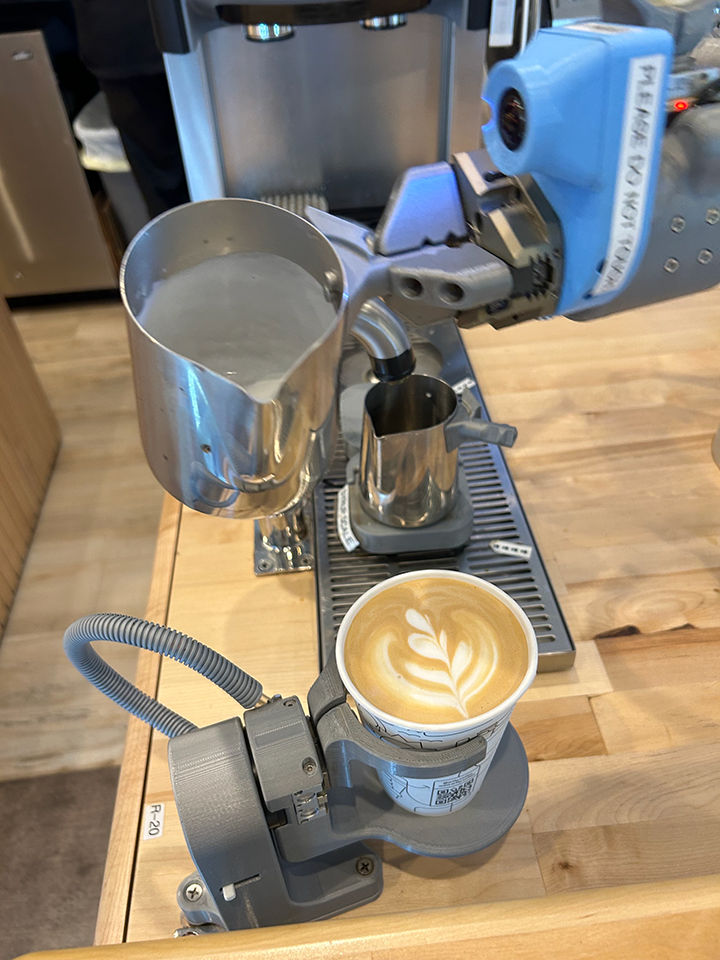
The Artly Barista Bot uses deep learning-based visual inspection to monitor drink quality at each step to ensure a perfect cup with every order. Photo courtesy Kathleen Stoehr
Automation meets expectations
So, what is driving the growing commonality of robotics in the hospitality industry?
“For one thing, the general public is becoming more accustomed to the idea of robots being part of everyday life,” says Kane. “It’s still a novelty, sure, but a fun one that can be a big draw for businesses that add robots to their operations.
“But on the business side of things, I can’t think of anyone in the hospitality sector that isn’t hurting for staff right now. The labor force just isn’t there. But the show must go on, and service robots have the ability to take care of a lot of the repetitive yet essential tasks that need to be done. This not only helps out the existing staff members, but can actually assist with recruitment if potential employees know that they’re not going to have to clean the floors or carry mountains of dishes back to the kitchen because we have robots to do that.”
Staffing solutions
Hiring and retaining catering staff is a constant headache given that foodservice and hospitality have one of the highest “quit rates” of any industry. Many catering companies are still struggling to find quality staff following the “great resignation.”
According to the National Restaurant Association, 65% of restaurant owners still say finding enough workers is a central problem, and one surefire way to augment serving staff while wowing guests is by taking advantage of robotic food service assistance.
“It allows us to rethink the customer experience, and redeploy people to hospitality moments,” said Dexai cofounder Nicolas Jammet in an article for the Boston Globe. “The team member gets to be friendly, and the engine gets to be fast and accurate.”
To ensure robots become an ally to service staff, it’s important to set expectations about what these automated co-workers can and can’t do. The most successful way to utilize robots is to have them perform physical, repetitive, and manually straining tasks, thus relieving staff from these duties. All these routine tasks, when handed off to a robot, free up front-of-house employees to do the more important tasks that require interaction with guests, like recommending the right dish, making memorable conversation or fulfilling a more specific ask. The robot allows staff to focus on what matters most: the overall dining experience.
“With manual labor and responsibilities handed off to robots, staff can spend more time with things that need a human touch, such as interconnecting with invitees and directing the event experience,” says Karen May, Chief Experience Officer for Scottsdale Private Event Venues (which deployed Pringle’s service robots during a recent event).
Selden agrees. “This enables the staff to do other jobs that require human interaction,” she says. “I think it would be a really fun ‘marriage’ of sorts. I want one for sure!”
Increasing efficiencies
Beyond alleviating staffing pressures and utilizing skills more effectively, robots can also be instrumental in enhancing productivity, efficiency, and in some cases even creativity.
With their advanced capabilities, robots can precisely measure ingredients, chop vegetables, mix dough, and perform repetitive tasks with unparalleled consistency. This not only saves time but also ensures uniformity in taste and presentation.
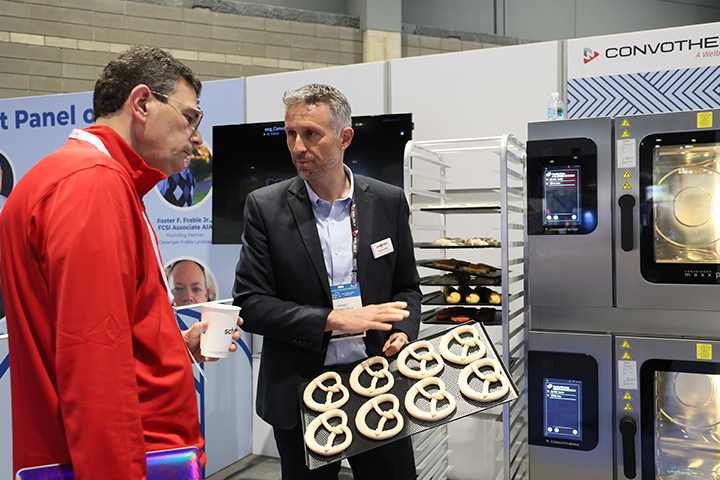
During the 2023 National Restaurant Association Show ConverTherm displayed its ConvoSense, the world’s first AI-powered combi oven for fully automated cooking. Photo courtesy National Restaurant Association
Additionally, robots can play a significant role in automating inventory management by ensuring accurate stock control and reducing waste. Equipped with sensors and cameras, robots can scan shelves and track inventory levels in real-time. They can alert staff when supplies are running low, allowing for timely restocking. This automated system minimizes human error, eliminates the need for manual stock checks, and optimizes the overall inventory management process.
Finally, robots can help to decrease on-the-job injuries. According to Global Market Estimates, every year, more than 300,000 individuals are injured in kitchen-related mishaps (such as burns, cuts, air quality concerns, and even ergonomic issues).
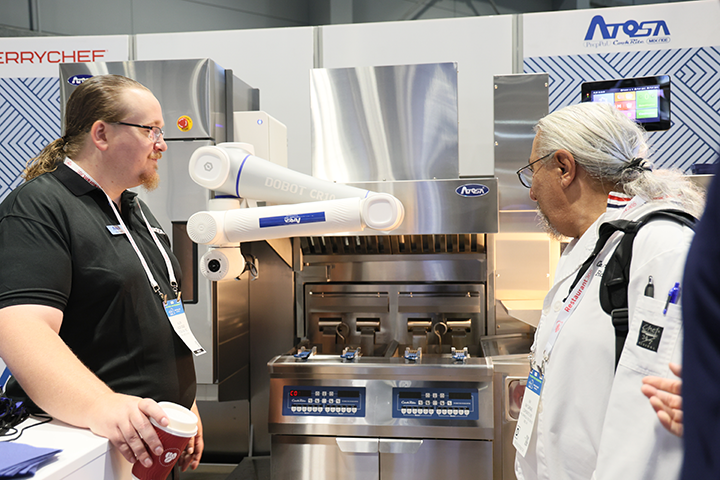
Artosa USA displayed its Intelligent French Fry Robotic Solution during the 2023 National Restaurant Association Show. The six-axis collaborative “co-bot” robot solution provides system adaptability during peak and non-peak times and allows the system to operate entirely manually when needed. Photo courtesy National Restaurant Association
Consider this anecdote that Jiyoung Hwang, Marketing Manager for Aniai, shared following the National Restaurant Show (where Aniai robots teamed up with culinary chefs from Savor throughout the conference): “One of the chefs shared an interesting insight with me. The chef mentioned that during catering events, he often has to cook thousands of burgers. In the past, he used to wrap wet towels around his arm for protection because the heat from the grill was too intense. But with our Alpha Grill, robots handle all the hard work for the chefs, allowing them to dedicate more time to creatively developing recipes.”
Making a moment
Lastly, the novel aspect of robotics during events can’t be overlooked. “Robots make us consider our own humanity, so what better way to get a room talking,” says May. Robots create that Instagrammable moment that caterers are always chasing.
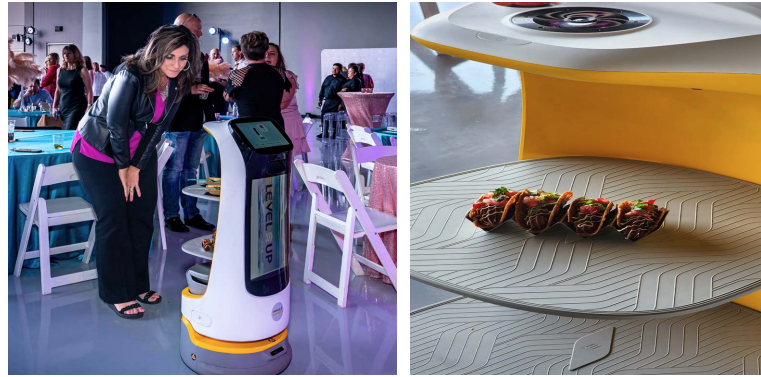
During a recent event, the Scottsdale Private Event Venues and Pringle Robotics deployed one of Pringle Robotics’ service robots (KettyBoT), where it displayed the event logo on its digital display while it delivered chocolate tacos to guests. Photo courtesy Dee Anne Deaton Grooveheads
“I know they’re gimmicks,” said Stavros, “but people love gimmicks.”
The robot revolution
As we look to the future, many speculate that robotics in the hospitality industry will move beyond just a gimmick or a novelty, but instead become part of the norm. A recent study by Lightspeed found that 50% of restaurant owners plan to install automation technology within the next two or three years.
“I believe that if anyone wanted to, they could go see a robot working in a restaurant in 2024, 2025,” said Jake Brewer, Chief Strategy Officer for Miso Robotics, in the CNBC article. “You can go see robots cooking right now and that’s only going to grow week over week.”
Not everyone is 100% sold on robots’ role in the catering industry, however.
“While I find robotics super cool and intriguing, I find it hard to imagine that they will ever replace fine dining service teams,” says Selden. “The level of service expected by our clients, especially in our market, is so personalized and next level.”
Footers Catering’s Anthony Lambatos shares similar sentiments.
“I think we are still a ways off for applications in the catering space,” he says. “I don’t foresee robots putting plates down in front of guests anytime soon,” he says. “[Although] I think we will see some initial applications that will be attention-grabbing and ‘trendy.’”
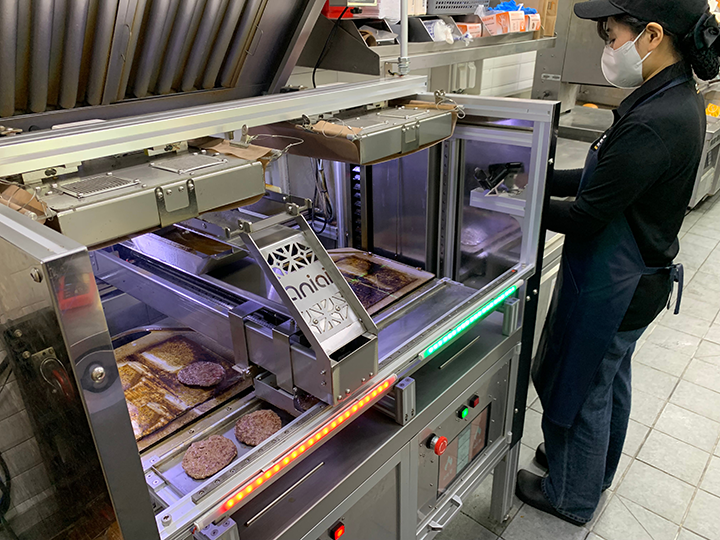
Aniai’s flagship product, Alpha Grill, is designed to cook hamburgers easily, efficiently, and with consistent quality. Featuring a double-sided grill design and a rapid cooking system, the Alpha Grill is able to cook eight perfect burger patties in under a minute. Alpha Grill is packed with AI components to check and control food quality. With an intuitive touch-screen monitor, users can customize cooking conditions, access real-time quality metrics, operational stats, inventory data, and more. Photo courtesy Aniai
The robots themselves will continue to evolve from “automation” (where they must be constantly overseen and programmed by catering staff and technicians) to have full autonomy within their respective roles.
“After the pandemic, there’s a new world right now,” said Ajay Sunkara, President and CEO of Nala Robotics. “Let’s talk about hygiene. Let’s talk about the labor shortage. Let’s talk about staff not showing up at all because of health issues right now. The best part of [robots] is consistency. You don’t have to do training. It always does the same thing.
“If you look at the catering world, I believe it can utilize automation quite a lot—I think it’s the best industry that can utilize technology.”
When it comes to the catering industry, the future means a symbiotic relationship between robots and humans. The integration of robotics into the catering industry is not about replacing human chefs; it’s about enhancing their skills and improving overall efficiency.
“The first-time people see a robot passing hors d’oeuvres they will be snapping pictures left and right, posting to social media and talking all about it. The question becomes—will it be sustainable? Will people continue to appreciate it or miss the connection with an actual person in the process? I believe companies will need to double down on their strategy when it comes to client-facing applications of robotics,” says Lambatos. “There will be those that look to highly automate everything and serve a market that appreciates that, and then there will be caterers that realize their clientele appreciates high touch/ high service and they will need to invest heavily in that. Understanding the market you want to compete in will be critical when it comes to introducing technology and robots into your business.”
Embracing this technological revolution opens a world of possibilities, where culinary creativity meets cuttingedge automation. The future of catering is here, and it’s powered by robots.
“Humans do what they do best. Let robots do the rest,” says Kane. “Robots, especially service robots, exist to do the dull, dirty, or dangerous jobs that can sap people’s time, joy, and motivation at work. Now no one’s saying that catering is dangerous, but there can be a lot of repetition, a lot of physical strain, and steps involved in catering and events work. When robots can automatically do some of the not-so-fun tasks, it creates a better environment for workers and their customers. People can focus on the higher-value work that’s uniquely human. And they do all of this without tiring. Basically, they allow great catering staff to be even better because they have the time and energy to focus on guest experience.”



